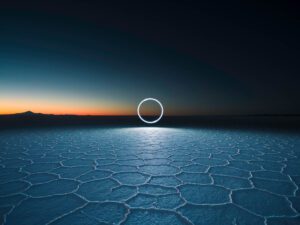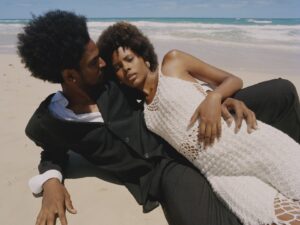“Expanded Photography” can be traced back to the turn of the 20th century when Cubist artists Pablo Picasso and Georges Braque first began experimenting with papier collé, adding newsprint and wallpaper to canvas. Simultaneously, in post- WWI Germany, Dadaist Hannah Höch (1889-1978) was making political collages and pioneering the form of photomontage, appropriating and recombining images and text from mass media. The idea: to critique popular culture, the failings of the Weimar Republic and the socially constructed roles of women at the time. The technique was adopted by the surrealists and, later in the 20th century, by pop artists.
Richard Hamilton’s Just what is it that makes today’s homes so different? (1956), sourced from a stash of American magazines, is a classic example. In the 1970s, Barbara Kruger emerged alongside the Pictures Generation. She gained traction for overlaying black-and-white pictures with bold captions in Futura Bold Oblique or Helvetica Ultra Condensed fonts. Elsewhere, John Stezaker (b. 1949) was layering landscape postcards and over vintage portraits – a technique which Lorna Simpson (b. 1960) also honed to great effect. Notably, she was the first African-American woman to exhibit at the Venice Biennale; her compositions depict Black women whose collaged hair spills onto the page like deep galaxies.

The shift of focus from painting to photography and, now, beyond is perhaps best described by painter Gerhard Richter, who, in the mid-1960s, ushered in a world of “not having to invent anything anymore, forgetting everything you meant by painting – colour, composition, space – and all the things you previously knew and thought. Suddenly none of this was a prior necessity for art.” Today, the definition of picture-making has broadened beyond point-and-click to incorporate new technologies, concepts and ideas that push the still image even further. There’s also been a return to traditional crafts. Julie Cockburn (b. 1966) is a key name in this space, alongside others like Alma Haser, Diane Meyer and Karen Navarro, who are selecting, cutting, pasting, sewing and repurposing pictures to create something new. Cockburn meticulously embroiders bullseyes, geometric shapes, spheres and starbursts onto faces, breathing second life into discarded portraits from times gone by. As her latest exhibition, titled Same But Different, opens at Brussels’ Hopstreet Gallery, Cockburn speaks to Aesthetica about her practice, and the emotional response her work can evoke in its viewers.
A: Tell us about how you first became interested in archival images – where did this big passion come from?
JC: I began working with found objects and images whilst studying sculpture at Central Saint Martins, London, in the 1990s. We were encouraged to use anything and everything as our materials. The process is akin to entering a pre-existing conversation, where I am bound by a certain language – offered by the photo, painting or postcard – but am never faced with the blank canvas. It’s about establishing a relationship with the object and seeing where that takes me. It’s an exciting way to work. I have been immersed in the world of photography since my childhood – mum worked at Scaioni Studios, a fashion and portrait studio in London. I remember it so well: the large rolls of coloured paper backdrops, the smell of developer and the large format cameras, and I think this is where I first fell in love with mid-century aesthetics. My grandfather was a brilliant amateur photographer all his life, and my cousin, Sally Anne Thompson, is celebrated for her animal photos. I generally use found pictures in my work, rather than take them myself.

A: Who – or what – are your inspirations? Are there any key figures from the history of art whom you particularly admire, or whose techniques you find yourself adapting?
JC: I keep revisiting the work of Pablo Picasso, and recently I have been looking at the graphic compositions of Sophie Taeuber-Arp. You can see how she influences me directly in works like Composition à Cercles et Demicercles (1938) and her geometric textile Vertical-Horizontal Composition (c. 1916). I love mid-century furniture design, too – the juxtaposition of experimental materials combined with organic simplicity resonates with the way I go about choosing an image or a motif. I often get inspiration whilst I’m walking my dog on the heath near to where I live. The natural world has begun to play a bigger part in my work since I moved out of London five years ago, and getting outside has given me time to think about ideas without the distraction of my studio.
A: Your artworks are instantly recognisable: rainbow thread, vintage portraiture and geometric shapes. Can you explain some more about this “signature” technique?
JC: I’m probably best known for my embroidered photographs. I was taught to sew by my grandmother who made beautiful, hand-stitched still lifes and landscapes in thread, so I have always had needlework as part of my skillset. People are intrigued to find out that I stitch everything by hand, but it’s the only way I can get the precision and finish that I want. I trawl the internet for a perfectly posed sitter with the right amount of unfettered background, or an archetypal landscape that we can all picture in our mind’s eye. Having selected an image, I start to embroider in a painterly way, adding blocks of colour and combining the threads to get the perfect hue – as one would mix paint in a palette. It’s really all about the composition. I sketch in Photoshop onto a scan of a found photograph, before finalising a design, which is then transferred back onto the original. I use the idiosyncrasies of each photo as my inspiration – the colour, posture, patina, format and composition – and I grab the “feeling” they instil in me as a guide to which pattern to choose. My colourful, abstract interventions add a physical depth to the picture plane, and they inject a form of personal narrative to the found images. I see them as a frame from a movie that I’m playing in my mind. My interventions are about manifesting emotional responses, just like a film scene.

A: Is there a specific idea or message you want to convey?
JC: I’m not particularly didactic about how my work is interpreted, nor am I driven by any political agenda. My most recent show, titled Same but Different at Hopstreet Gallery in Brussels, focuses on the process of looking at a picture and how we all tend to interpret the same image in different ways, depending on our own personal histories. My work loosely hints at Jacques Derrida’s philosophical concept of La Différance (1963). The idea is central to his field of deconstruction, and it’s all about the relationship between text and meaning. Moreover, I’m trying to encourage everyone to have an individual reaction to the work by making my own response and feelings visible on the surface, using a very personal and carefully honed visual language.
A: Do you have a favourite piece – or series of works – that you’re particularly proud of? Or does that change?
JC: I’m one of those artists who is never completely happy with anything I’ve made, which spurs me on to make the next one better. But when I look back at work from, say, last year or 10 years ago, I’m always quite pleased and often think “Did I make that? Wow!” My pictures are like my offspring so it’s difficult to choose a favourite, but I don’t want to keep them for myself. I like that they go out into the world. I’m pleased at how my recent large works, Tree (Red) and Tree (Yellow), turned out. I generally work on a small, intimate scale, so it’s a refreshing change to work on bigger pieces. This has been an adjustment both physically, as my body can sometimes freeze from RSI when working with intricate stitching on small photographs, and in terms of how my works are viewed. Rather than the close scrutiny my smaller embroideries receive, it’s nice to have the viewer step back from these larger works and see them from a greater distance.
A: What’s been the big highlight of your career to date?
JC: Every day I appreciate being fortunate enough to work as an artist full-time. I have my galleries – Flowers Gallery and The Photographers’ Gallery in London; Hopstreet Gallery in Brussels; and Galerie Ramakers in The Hague – to thank for that. Their long-term trust and support has been invaluable; working as an artist is a solitary process for me, but their guidance and input has made sure it is never a lonely one. Whenever I have time, I also like to enter a competition and I have been lucky to get work accepted into the John Moores Painting Prize twice. Those were good “yes” letters to receive.

A: Do you have any favourite contemporary creatives?
JC: I love the work of so many artists but am unable to visit as many exhibitions as I used to. Instead, I spend a lot of time scrolling through Instagram to find new and exciting practices. My go-tos of the moment are Francis Alÿs, Jane Morter, Jonathan Callan, Kerry James Marshall, Patricia Treib, Rob Wyn Yates, Yayoi Kusama and more. The list is endless. I’m also looking at the work of the ceramicist Florian Gadsby, garden designer Jelle Grintjes and jeweller Ben Day, plus videos of Japanese ikebana flower arrangements and contemporary cake decorating. My body of work combines fine art with craft, so I am equally drawn to both disciplines.
A: What are you working on? Any shows or new projects?
JC: I am making a new body of stitched works for Art Rotterdam in early 2024, where I’ll be showing with Galerie Ramakers. I’m in the process of planning a series of largescale photo collages based on tiny found family snapshots and tinted postcards. As I mentioned previously, there’s also my show at Hopstreet Gallery, which runs until 22 December. Recently, I have become passionate about pottery and attend a workshop once a week where I am learning to throw pots on the wheel. It’s a skill that I’m determined to master and somehow aim to incorporate the beauty and resilience of glazed ceramics into my working practice. Varying techniques and working at different scales keeps the creative process interesting for me and, hopefully, for the viewers too.
Same But Different, Hopstreet, Brussels | Until 22 December
Words: Eleanor Sutherland
Image credits:
1. & 2. The Author (2021). ©Julie Cockburn. Hand embroidery on found photograph. Courtesy of Flowers Gallery, London.
3. Flare 3 (Red) (2023). Hand embroidery on found photograph. © Julie Cockburn. Courtesy of Hopstreet Gallery, Brussels.
4. Flare 2 (Blue) (2023). Hand embroidery on found photograph. © Julie Cockburn. Courtesy of Hopstreet Gallery, Brussels.
5. Confidence (2021). © Julie Cockburn. Hand embroidery on found photograph. Courtesy of Hopstreet Gallery, Brussels.





